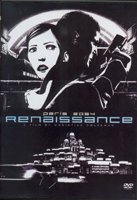
Arch
443/646: Architecture and Film
Fall 2007
Renaissance
2054 (2006)
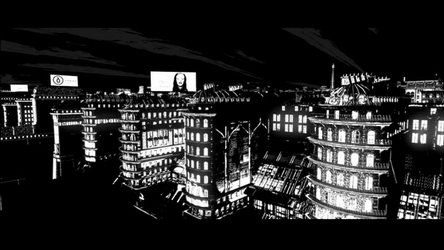
 |
Arch
443/646: Architecture and Film Renaissance
2054 (2006) |
 |
Discussion Questions:
Remember, your images are ABOVE your name.
Please answer the questions below. Use paragraph form. Your answer should be around 400 words. Email me your responses in Word .doc format to: tboake@sympatico.ca I will be posting these each week after the class. You should be prepared to deliver your answer in class -- but paraphrase, do not read it. THINGS TO KEEP IN MIND WHEN ANSWERING THESE QUESTIONS: I am looking for general observations about the film and the relationship to any aspect of the Uncanny that we have examined. The images attached to your "words" are to clarify the intention but are not meant to be action specific. We will be tying these questions to Sin City next week. |
| 1. | 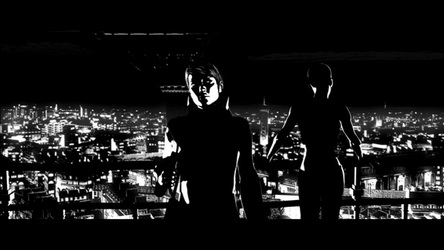 |
||||
Adam Brady The film Renaissance uses a rare visual style in which almost
the entire film is predominately black and white. This type of animation
appears very pure in its design. It displays as white spots on a very
dark screen. The white is mostly used to detail exclusively black figures
and objects, and is found to be much easier to read when used in lower
quantities.
|
|||||
| 2. |
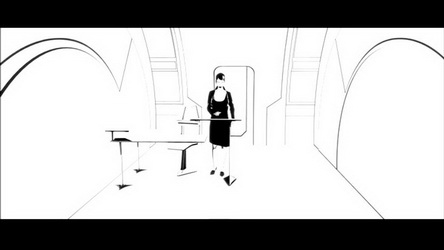 |
||||
Cassandra Cautius Christian Volckman’s French animated film; Renaissance was created
using computer generated imagery, almost the entire film is black and
white with occasional grayscale and rare glimpses of color. The
use of white and black is obviously tied to light and shadow, used to
give form to the shot and create contrast. But there are many instances
in the film where white is specifically used in odd or uncanny ways.
When Ilona is kidnapped from a dark Parisian alley the alley is flooded
with white in the space where her abduction occurs. When investigating
the kidnapping, inspector Karas goes into Avalon where Ilona worked,
to have a chat with Jonas Muller. The way the scene is set up it depicts
a good cop, bad guy situation to stir questions in the viewer right from
the start of the film, to put distrust onto Avalon, of which the viewer
is suspicious but has no real clue yet as to the role this corporation
is playing in society. During the interrogation scene Karas is almost
entirely dark and in the dark, and Jonas, while working in an operating
room, is pure white as is his setting. This reversal of the normal polarization
of black and white actually manages to enhance the doubt and suspicion
of the mysterious Avalon. Another example of this is clear in the face
of Avalon. The woman pictured on the billboards appears to have a distinct
morphology to her features but generally her face is pure white, to the
degree that it seems to loose form. This face is not a still shot of
a model but rather a form of interactive future advertising where the
face watches, speaks to, and follows a person. It is difficult to discern
if this woman is beautiful or not, it would seem likely that for her
position she must be very beautiful, but it plays into the style of the
movie that the animation reduces her features and the use of white removes
all form until her face appears to be completely one dimensional, and
the mistrust of Avalon grows.
|
|||||
| 3. | 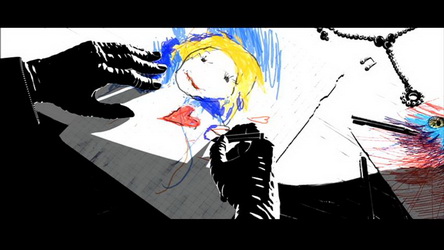 |
||||
Alexander Chan The use of colour is striking in the film Renaissance because the entire
film is in black and white. This contrast empowers colour giving it significance
and value. We as the audience are disturbed in our film viewing because
there is this drastic change in colour value. Our attention is drawn
to the screen and we do not notice anything else happening asides the
shades of colour. This technique is good at highlight things in the set
to catch our attention.
|
|||||
| x | 4. | 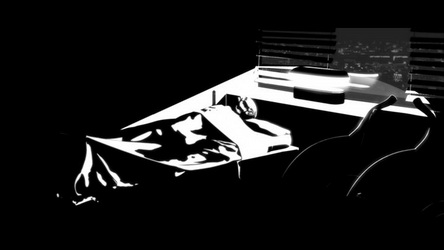 |
x | ||
David Henderson Throughout history, black and darkness have been associated with notions
of mystery, whereas white, its opposite, more closely associated with
and clarity. Renaissance: Paris 2054, takes
this idea and switches it around, using darkness to illuminate, and light
to drown things out. Scenes in which black or white is overwhelming are
scenes in which a strong good or evil force is present. In films, contrast
is often used to portray the intensity of the scene but in Renaissance,
high contrast represents the less intense scenes while intensity is shown
by an overpowering of a certain tone, another reversal of usual film
techniques. Most of the scenes in the movie are shown with a balance
of white and black, making the scenes in which this balance is upset
are of particular importance.
|
|||||
| 5. | 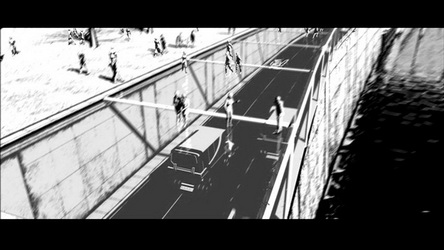 |
||||
Minwoo Lee The use of transparency in the film Renaissance 2006 is very carefully
laid out in the construction of the visual and narrative composition.
The director utilizes these visuals as implicit devices that portray
of underlying narrative and subtle projection of the character’s
inner world. It is observed that the use of transparencies occurs on
two basic ideas, segregation and contemplation. In both cases,
transparency relates to the scission between oneself from the surroundings,
the retraction into the inner self. Consequent of this retraction is
the fact that one’s true intentions are hidden from others and
the narrative exists in the dual path of exterior and interior worlds. Apart from the symbolic meanings, the use of grey also distinguishes the depth of field by creating an intermediary layer. This emphasizes the notion of separation which is difficult to express by the singular use of black and white. The provocative representation of underlying strata of a city would not have been possible without this grey transparent layer, as the black and white of the multiple layers would simply merge together into a singular plane. |
|||||
| 6. | 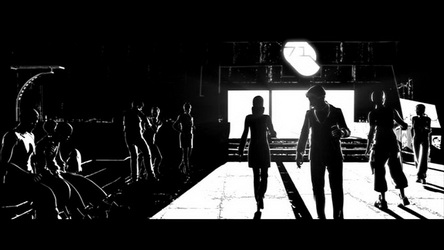 |
||||
Paula Lee The animation film Renaissance by Volckman emulates life in futuristic Paris 2054. In its colourless view scope of flat black and white images, the effect of low-key single-source lighting that creates distinct silhouette draws depth and perception. Human figures are presented with varieties of outlined silhouettes, perpetually backlit and in many scenes their faces are half-lit chiaroscuros. As a result, the figures seem to sink themselves into background ink while the setting depicted without silhouette seem to pop out in its flat black and white scheme. The silhouettes also add the perception of reality to figures as the folds and wrinkles defined with this technique add the sense of motion and life. This draws contrast to the gesture of the city that looks rather lifeless and dramatic without vibrancy of motion. The images are either dominantly black or white, and in this setting silhouettes plays as a source of depth, giving life to the figures. The nuance of well-defined figures and flat setting seems to create a glandular gesture of emphasizing motion throughout the movie- sometimes the figures are the only part of the scenes viewers can distinguish. There is a sense of unbalance in the plays of black and white throughout the movie, as they represent the opposite, often creating a great contrast in tonal values making some of its scenes almost unrecognizable or flashy.
|
|||||
| 7. | 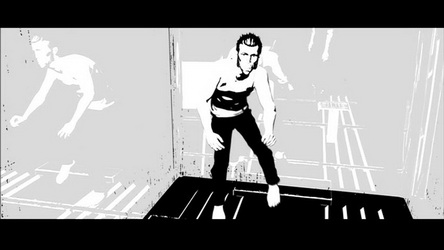 |
||||
Evelyn Lo The
film, Renaissance has adopted the classic 'film noir' style and has exaggerated
it to create a visually stunning films that through well crafted visual
effects create a strong sense of the uncanny throughout the film. The
film rely heavily on visual ambiguity to prompt a sense of unease, disorientation,
suspense and fear through visual effects; particularly, the reflections
in Renaissance.
|
|||||
8. |
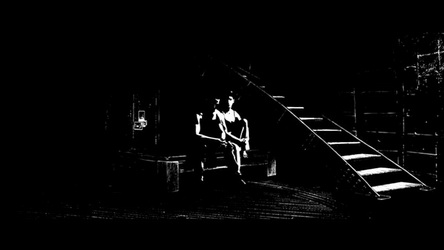 |
||||
John McFarlane Spotlights are used in Renaissance to create the sensation of isolation. They serve to disconnect the action from its surroundings by shrouding the peripheral material with darkness. The isolation that spotlighting creates is one of the ways that the film creates a sense of “uncanny” in the sense of that pertaining to modern life in the metropolis: the individual alone in the crowd. Spotlighting is also commonly associated with performances so that watching a movie such as Renaissance which portrays a story as if it were real while simultaneously lighting it in a way that suggests a staged presentation creates an uncanny disjunction in the mind of the viewer who is confronted with not only the ambiguity of the stylized reality portrayed in film but also the sense of unease inherent in the idea of people being watched emphasized by the spotlights and the nature of the Avalon Corporation. This condition of modern cities in which there are too many people to be acquainted with each of them and social relations become abstracted as people become anonymous is a part of all the films we have watched so far, with the exceptions of The Cabinet of Doctor Caligari and The Golem, which portray an earlier way of life in smaller communities. While Metropolises 1927 and 2001, Playtime, Bladerunner, and The Fifth Element make use of the properties of this condition sometimes to further the plot (such as the polemic abstraction of ideas and people in Fritz Lang’s Metropolis) and sometimes almost unintentionally as an extrapolation of the current state of existence in the city, I, Robot and The Truman show play it up as a major theme. In I, Robot it is evident in the simplistic juxtaposition of Will Smith’s Spooner character, representing a nostalgic view of the past, with the world around him, a hypothetical demonstration of the condition of modernity driven by technological innovation. The Truman Show evaluates anonymity as well as surveillance in a more open-ended and less Manichean way by positing Truman’s artificial idyllic life as being in a town in which everyone knows him and comparing that condition to the reality of life outside the dome: millions of anonymous spectators watching Truman in order to capture the feelings of normalcy and social happiness that he embodies in his initial naivety. These two movies relate back to the use of spotlights in that spotlights are used to isolate the characters for surveillance while darkness represents safety. In this manner the benefits of anonymous existence can be read into the scenes in that the isolation that spotlights create and which is symbolic of individual isolation in the metropolis can also be taken away by the light which, in isolating a character, defines them, stripping them of their place as one of a crowd, and bares them to the scrutiny of the power behind the light whether it’s the Avalon Corporation or The Truman Show’s cast and production assistants. The spotlight also refers to a higher authority of some kind in that that kind of lighting implies a strong source of light somewhere off the screen. The characters caught in the spotlight are in the presence of whatever power has created the light, as in Renaissance in the scene in which the inspector is beaten by Avalon security after the doctor gets himself killed. After the inspector falls to the ground, the scene is seen from above, showing the doctor and inspector lying in the shallow snow illuminated by a harsh circular light from above. In this case the authority the spotlight represents is that of the Avalon Corporation, which has indirectly killed the doctor and directly battered the man trying to uncover its secrets.
|
|||||
| 9. | 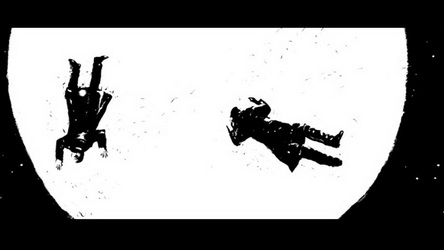 |
||||
Sava Miokovic |
|||||
| 10. | 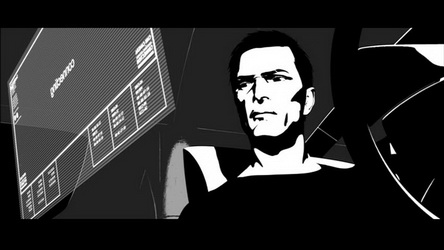 |
||||
Reena Mistry The use of low angle shots in Renaissance 2054 is one of many elements of the film that resonates the visual style of film noir. The low-angle shots are used in addition to the harsh contrast lighting, shadow casting, darkness and narration typical to film noir expression cinematography. More recent films in this style have been recognized as the forefront for structural experimentation, in terms of narration (such as Pulp Fiction) and in the same manner, Renaissance 2054 pushes the boundaries of the visual style of film noir. The essential ingredients are used, but the graphic manipulation of the media tests the boundaries of both live action and animated film. The effect of the low angle shot is used to produce disorientation. The unnatural perspective generated is not a normal eye view, but rather either a non-human viewpoint or the viewpoint from an inferior view. The non-human viewpoint, such as that of a camera, plays along with the theme of surveillance in the film. The film shot chosen above is reminiscent of the shot of Truman from behind his car radio in The Truman Show. In this film’s futuristic Paris, it is never quite clear when one is being watched or is truly alone, and these film angles feed this uncertainty. The inferior view produces a distortion of the surroundings making the subjects in the shot seem much larger, powerful, and ominous than possible from a natural view point at eyelevel. This adds to the narrative and the depiction of characters. This vantage point allows for a greater view of the surrounding environment with a vertical emphasis, which is used to reveal layers of information beyond the scope of the horizontal plane of events. Used in conjunction with the transparent floors of Paris in 2054, these low angle shots tell two events simultaneously (such as when Karas enters a train underground whilst his friend is attacked on the ground plane above). Traditionally, shots through distorting objects such as glass are used as a film noir means of producing a bizarre view. Used with the low angle shot, especially in this example, Renaissance 2054 proves to push the new age film noir cinematography.
|
|||||
| 11. | 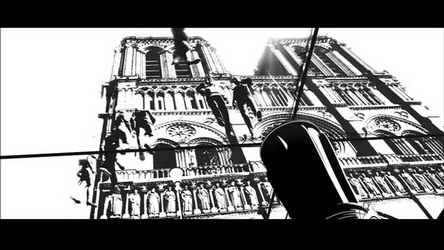 |
||||
Melissa
Ng Christian Volckman’s Renaissance 2054 is a film
that takes place in future Paris with remnants of old Paris as part of
the set. Volckman uses icons of Paris to establish the grounds
of the Paris setting – to familiarize the viewer of this futuristic
world through recognizable infamous architecture. This film is
able to create an uncanny feel not only simply through the use of old
architecture in the new futuristic world, but is able to create the sense
by the way we view the architecture in the film. Since its erection
nearly millennia ago, the Notre Dame de Paris has always been infamously
viewed the same way. The infamous picture of this iconic building
has always been from the front façade, standing on ground level. For
nearly a millennia, man has viewed this building the same way. In
2054, the time of which this film has been set, we view the cathedral
from a whole new realm. The ground level has been stripped of its
concreteness and replaced with a thin, transparent glass. In less
than five decades, man has created a whole new way of seeing things,
or of living. When we look at the short time period of which the
world has taken to completely transform the way we perceive things, it
leaves us with an eerie sense. A world of which is recognizable
through its iconic buildings is unfamiliar to the viewer as a world of
their own through the film’s use of depicting the icon in a whole
new way through the eyes of the perceiver. |
|||||
| 12. | 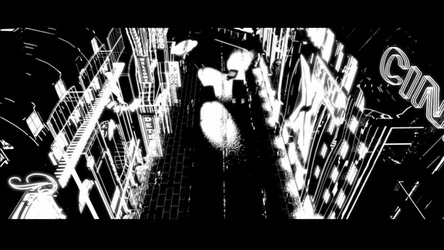 |
||||
Aisling
O'Carroll Christian Volckman's film Renaissance, set in Paris in 2054,
depicts a Paris of the future, with roads, city squares and buildings
of the future. Volckman, like many directors previously studied in the
term, includes architecture of the old city as well. This makes the film
more uncanny because the setting becomes more believable and the audience
can relate to it easily. |
|||||
| 13. | 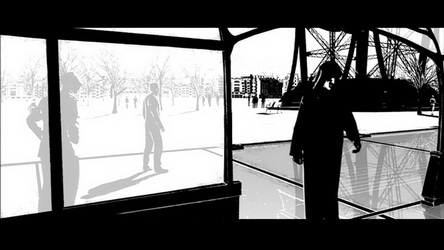 |
||||
Shannon Ross The use of layers in Renaissance is quite prominent. Because
the film is in monochrome the layers vary in tone to give a realistic
sense of depth. The are also layers of architectural elements. For
example, there is a elevated walkway that is transparent. This
is uncanny because of the visibility through the walkway, allowing one
to be viewed from atop. |
|||||
| 14. | 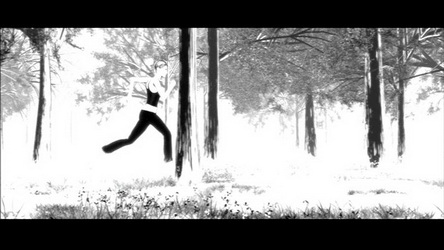 |
||||
Terry
Sin Renaissance is a film of contrast in many senses. One such contrast is between the built and natural world. While nature only presents itself very briefly in two scenes, they provide important means of creating visual disorientation. In both scenes where nature is present, trees are used to disorient or confuse the characters. The vestibule to Jonas Muller’s apartment is a presented as a grassy forest and is a striking contrast to the built world surrounding it. Since nature is barely present in the movie, this scene makes the viewer question why there is a forest in an apartment and where the other forests are. In the following action scene also utilizes the trees as blocking, hiding and revealing the enemies and hero throughout the shoot out. Similarly, in the scene where Ilona is held captive, a simulation of a forest is effective in disorienting the character. Compared to the built world she is used to there is no order or recognizable structures and ends up running aimlessly. Nature again seems out of place and uncomfortable, especially because in this case, it is not even real nature. Its formation is an unnatural time lapse growth from nothing. It both cases it is also chilling to believe that trees and plants are so rare that they are only present in simulations or in the penthouse apartment of a wealthy scientist. In a way, the natural world depicted in Renaissance seems unnatural. Since the rest of the world is built, nature seems out of place. In order for it to be present it needs to be built itself, thus making it feel even more unnatural than the built world. All the built areas of Paris seem to have a natural evolution, such as the glass layers, but the natural elements are static and placed. These strange contrasts link to the notion of the uncanny. Nature should seem like something that is comfortable, or least, natural. In Renaissance, the natural world is artificial, replacing common notions of nature, similar to the idea of an animal in Blade Runner.
|
|||||
| 15. | 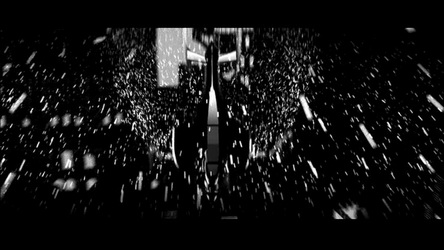 |
||||
|
Paris depicted in Renaissance 2054 is one of control and surveillance in which contemporary society is imposed on in every way by the youth and beauty company Avalon. Rain in this film is something beyond human control which can help characters find some higher ground out from the control of the systems of surveillance. It makes some hidden things visible and some audible things invisible. The appearance of rain appears mainly when there is some stealth going on that muffles the sounds of people to the unsuspecting target. The rain often helps us identify the whereabouts of Avalon’s invisible henchmen because of the rain splashes that could be seen around their person even if we could not see them ourselves, this effect of the outside world beyond their control made them visible.
|
|||||
| 16. | 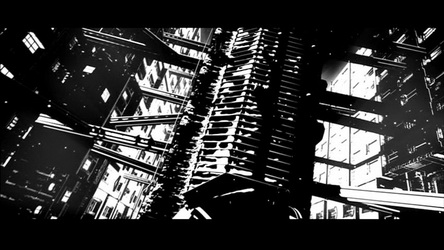 |
||||
Jamie
Usas The representation of materials in Christians Volckman's Renaissance appear to the viewer as a temporal conversation between Paris of yesterday and Paris of tomorrow. By associating dark, heavy, and impenetrable materials with the past city; and associating transparent, light and fragile elements with the future Paris, a duality is generated which is consistent within other elements of the film, such as the relation between black and white, dark and light, good and evil. The old, heavy materials of Paris, such as concrete and cast iron, are consistently rendered as solid, black, filled in structure, suggesting a permanence that withstands change. This quality can be observed in rendered buildings such as churches, or the iron structure supporting the tracks of the elevated train. Conversely, the materials of the future Paris are rendered with thin, light lines, unfilled, through which light easily passes, inferring the fragility of which the future city is built, and it's tendency towards temporality. This is evident in the rendering of glass structures and future infrastructure systems, such as highways and bridges. The representation of materials in Renaissance suggests a major discourse between the strength on which Paris was built and has lasted, and the superficiality of it's futuristic adaptation. Although no clear bias towards one side or the other exists, it is undeniable that a point was made to incite the conversation.
|
|||||
| 17. | 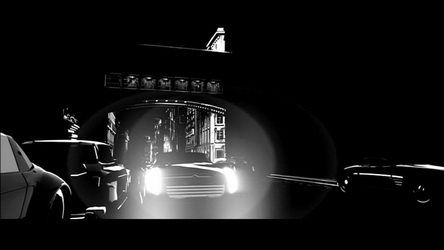 |
||||
Susan Varickanickal In the film Renaissance, the evolution of technology from present date to the future Paris portrayed in the film, is clearly obvious. However, with the extensive progression of technology, the automobile still carries the same role as it has in the past. Although the exterior model of the car has changed to a more advanced design, the idea of driving a car in a time where a there is a formula to promote immortality seems a bit absurd. With all the technological advanced clearly promoted throughout the film (i.e. reversing the signs of aging, the Motorola communicating device, recreation of a natural environment) the role of the automobile still carries its primary role in films. The car chase scenes in films has played integral role in building suspense and drama. By including the automobile, and the problems which arise from a high volume of cars such a traffic jams, one questions the development of technology in the film; however, by incorporating the use of automobiles in its classic sense, the director was able to recreate Paris in a futuristic manner and still carry out scenes with a familiar technology to allow the viewer to relate to the excitement of a familiar scene. Although the advancement of the automobile does not coherently follow the era which the film portrays, its still plays an integral role in allowing the film to be more comprehendible to the viewer. The viewer is able to relate to the characters actions while they are driving in their vehicle.
|
|||||
| 18. | 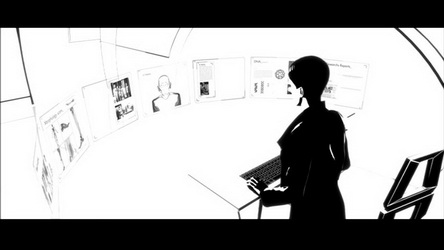 |
||||
Chao
Lun Wang The technologies depicted in Christian Volckman’s Renaissance 2054 are often a challenge to the personal privacy and security issue of the people. Voyeurism, to see and not to be seen, is the first key concept in the film that evokes the sense of uncanny. However, the voyeurism in this particular film is not related to perversion or lust, rather it stems from the purpose of surveillance. People can be traced at every turn of the street, their daily lives are monitored and can be manipulated if desired. The imprisonment of Ilona Tasuiev after her kidnapping is a particularly uncanny case since a virtually infinite environment is constructed in a limiting space to keep her disoriented and detached from any sense of place. This disturbing environment frightens her to the verge of mental breakdown, while the captor of Ilona enjoys her act silently across a screen just a few feet away. Other alternatives that also enable people to see without being seen include the night vision goggles and the invisible cloak, both of which are preferred by the hitmen of Avalon. These technologies enable them to sneak upon their prey and strike with the least amount of retaliation. One fears the unknown and the forces that he can’t perceive, thus the two are effective weapons for those who craves to control. This fear is clearly evident in the two particular scenes when the technologies were in action. The targets in each case, Bislane, who was preyed upon in total darkness by the security crew equipped with night vision goggles, and Montoya, who was preyed upon in broad daylight by hitman under invisibility cloaks were both helpless and moreover, shivers in fear. The technologies in Volckman’s film, which bluntly violate personal privacy and security are not unforeseen. Instead, they have already been implemented by political, economical, and armed forces of today. It maybe more uncanny to become aware of such methods of surveillance and control in our own society since privacy and security are highly valued by us, and that we could have never have speculated them.
|
|||||
| 19. | 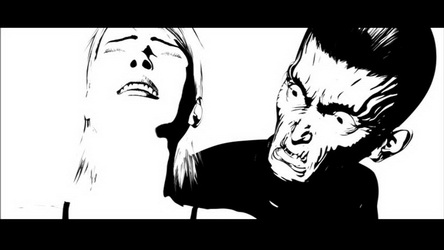 |
||||
Benjamin
Wong The film is a creation of a colourless world of flat black and white images. Everything seems to be so simple. Everything is black or white, good or evil; it appears to be a Manichaen world. The faces even appear to further support this idea of a clear distinction between opposites. Each character has their distinct appearance. Ilona, so innocent and pure, is only an intelligent young scientist who had become entangled as the victim of a mastermind plot; and why should this be questioned, when she certainly looks the part. As the story goes, footage is found of Klaus taking part in the kidnap of Ilona. Klaus looks monstrous. His face is so wrinkled and inhuman, that it becomes difficult for an audience to identify with him as a human being. What his motive was to kidnap Ilona is simple: Klaus and Muller are the monstrous, mad, aged duo of villains, who kidnap Ilona to stop her from uncovering a dark secret. As the storyline progresses, it is easy to see that these assumptions really have no place in the film. The simplicity of the black and white images serve not to reveal everything in a Manechaean light, but to obscure. The black serves to cause a great deal of anxiety and suspense in the film. In particular, is the scene in Renaissance, when the security guards turn out all the lights so that anybody without night vision glasses is unable to see. This idea translates into the animation of the faces. The clarity in which the audience perceived the characters is shattered when the Karas realizes that Muller and Klaus have only been trying to protect the world from Ilona. Ilona had uncovered Muller’s research on immortality. In the hands of Avalon, this technology would surely mean disaster and chaos for the world. Our understanding of Klaus and Ilona then, have been completely wrong. Their part in the battle of good and evil is really the opposite of what one might assume: Klaus, the good guy in the mutant body, and Ilona, the beautiful mad scientist seeking personal glory. Yet, even this is not complete in describing the characters. One cannot say that all characters are the opposite of what their faces tell us. The head of Avalon, for example, has a character that holds true to what his face portrays as someone not to be trusted.
|
|||||
| 20. | 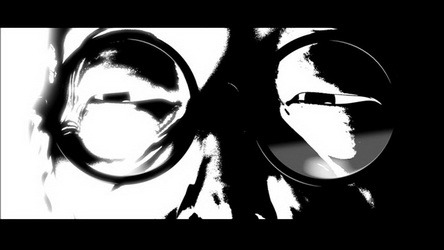 |
||||
Erin
Corcoran Eyes as a symbol are representative of many things. They can be associated with understanding, omniscience or truth, just as “looking someone in the eye” is a saying representative of honesty. If eyes alone are to be considered truthful, then, also, the covering or distortion of the eyes presents an idea of being deceptive or holding something back. Within the plot of “Renaissance”, graphic techniques used throughout the film and also applied to the rendering of the eye, and are more often than not used to mark which characters are to be considered honest and which are to be understood as deceitful. There are two major techniques for the rendering of the eye used within the movie. The first is a more realistic rendering, where the character’s eye, though only black and white, has first, a visible pupil, and second, some attempt to show realistic features; eye lashes, creases, etc. This technique, as seen in the left-hand images, is used throughout the movie on the three main characters, Karas, Ilona and Bislane. These characters are the ones with who the viewer is meant to identify, and in that way their eyes are rendered in a familiar, realistic fashion, making it easier for the audience to connect with their otherwise very visually abstracted forms. The second form of rendering, used primarily on characters of dubious vision (evil scientists, Farfella, Avalon’s CEO and the Billboard Model) is the blackening and over-simplification of the eye, as well as the almost cartoon rendering of the eye itself, often only symbolizing it with a simple straight outline. Unlike the other characters whose eyes are rendered with care and some semblance of realism, these eyes are quickly outlined and present visually as a sort of simulacra to the real thing - perhaps symbolizing that you should think twice before swallowing any information from them.
|
|||||
| 21. | 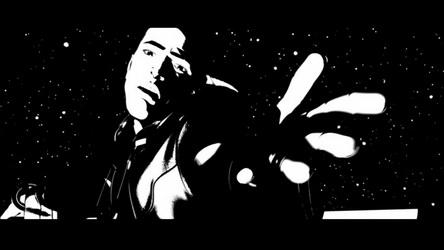 |
||||
Matthias
Heck In general, human emotions and feelings are shown through body language and gestures, but even more through facial expressions. As the movie has a strong and reduced black/white contrast with only few colors or grey shades, we as the audience necessarily concentrate more on the details of certain scenes, especially closeup views of characters and faces. For the development of the story and the whole movie it is therefore crucial to show the facial expressions in an appropriate way to convey different moods of the characters. The directors achieved this not only by choosing actors with intense facial expressions and recognizable facial traits, but also by the (facial) motion capturing technique that allows for an after treatment of recorded markers on the virtual 3d models to exaggerate certain characteristics. With the eyes and the mouth being the main parts in the human face that show and transport an emotion, we find many scenes where the face is highlighted and these two characteristics stand out. In other scenes however, where we see a closeup of a person’s face that is almost covered in black shadows, we always see both eyes and the main part of the lips stand out - in contrast to what it would look like in reality. Considering all these factors, the expression of feelings through facial expressions tends to be almost a caricature, an exaggeration of what is normal. Having this in mind and disregarding the static element, it is self-evident to draw a parallel to theatre plays or even classical pieces like historic roman or greek plays, where the main actors would wear face masks to portray their expressions in a more insistent way. Certainly, another source of influence is the genre of comic books and graphic novels, where we find a similar phenomena of depicting emotions. Next to the obviously visual effects, the music or the score plays an even more important part in transporting a mood or a whole atmosphere in any movie. Subtle use of music often subconsciously changes the way we perceive a scene, and even the whole movie. Nicholas Dodd, who composed the music for the Renaissance movie, chose a classical orchestra to accompany with the visual material. This orchestral score for Renaissance is very sentimental and vividly, hence enforcing the effect of the emotions and supporting the whole theme of the movie.
|
|||||
| 22. | 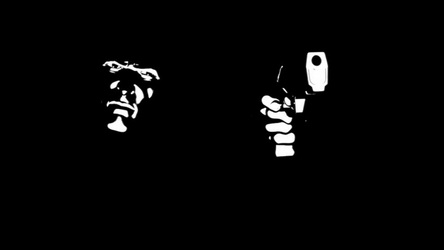 |
||||
Suzanne Gibson |
|||||
| 23. | 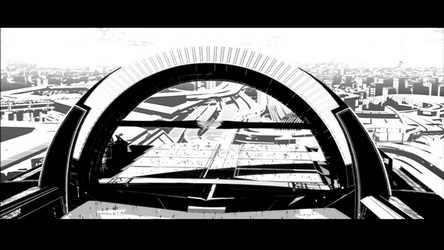 |
||||
Kate Gould Christian Volckman’s Film Renaissance 2054 depicts the Paris of
the future, which shows an interesting relationship between the old city
and the new. The infrastructure and architecture of the new city
has been built around the old, leaving it untouched. The older
city is shown as dark and underused, appearing to be quite uncared for
in this new futuristic Paris. The architecture of the new city
is quite uncanny as it is often parasitic, being built above or around
the architecture of the old city, preserving and protecting it. In
the public realm the traffic infrastructure appears to have been built
alongside the river, while entire plazas are built as glass floors overtop
of the old city. In the private realm the new architecture is also
very distinct from the old city. For example to get to Jonas Muller’s
laboratory one would enter into an elevator that went up the side of
the building into the building that balanced above. The futuristic
architecture is also very bright compared to that of the old city as
it is mostly, if not solely, composed of glass. The Avalon headquarters
rises above a plaza below with the office of the head of the company
suspended inside the semi-circular arch. This is a form of dominance
as his office could only be reached through the one heavily secured corridor.
|
|||||
updated 23-Dec-2007 10:41 PM